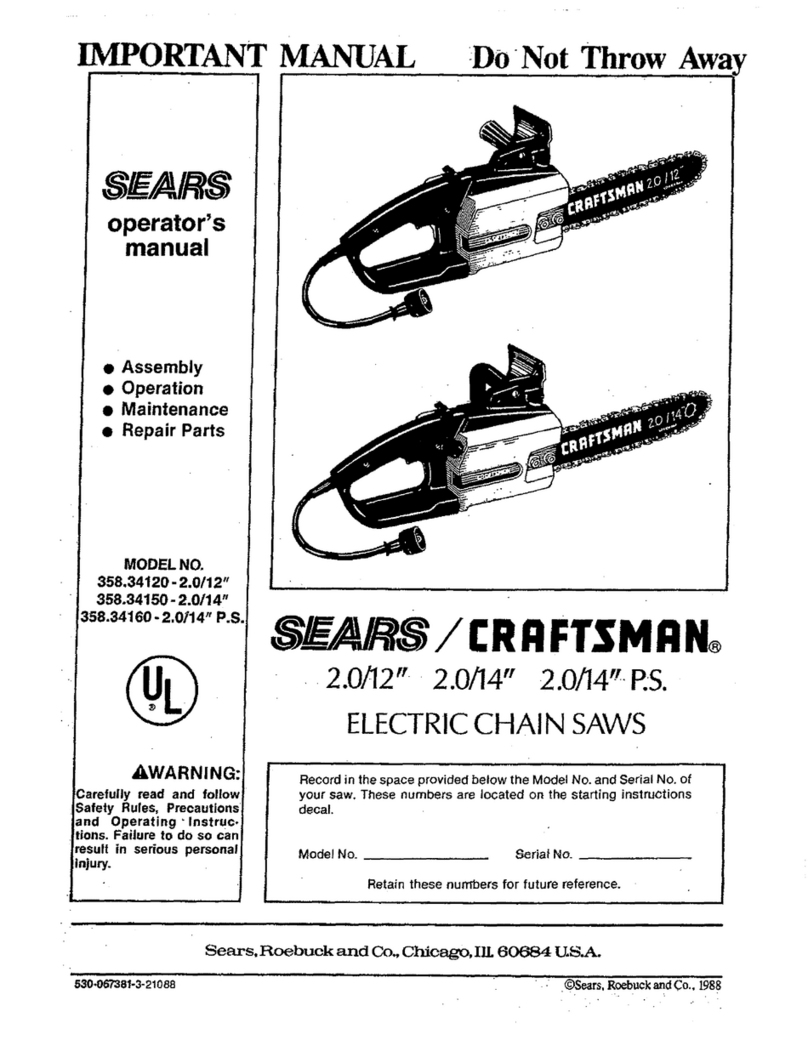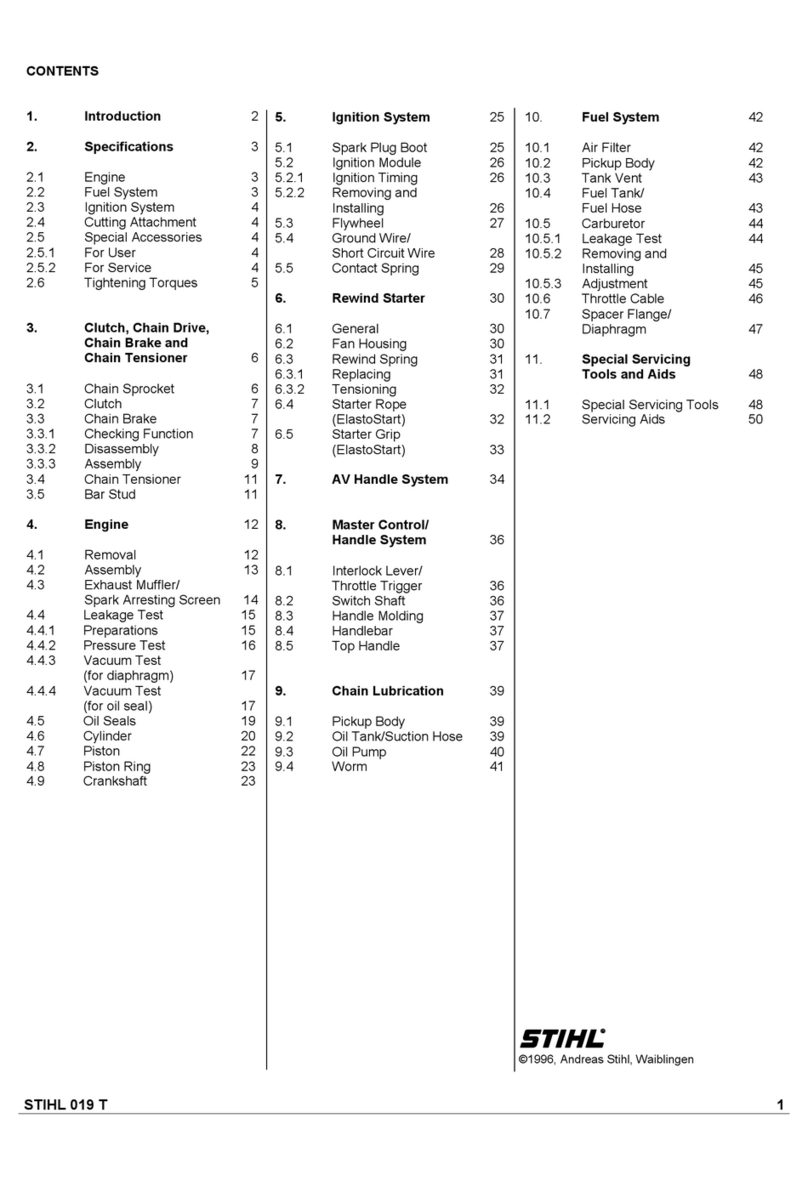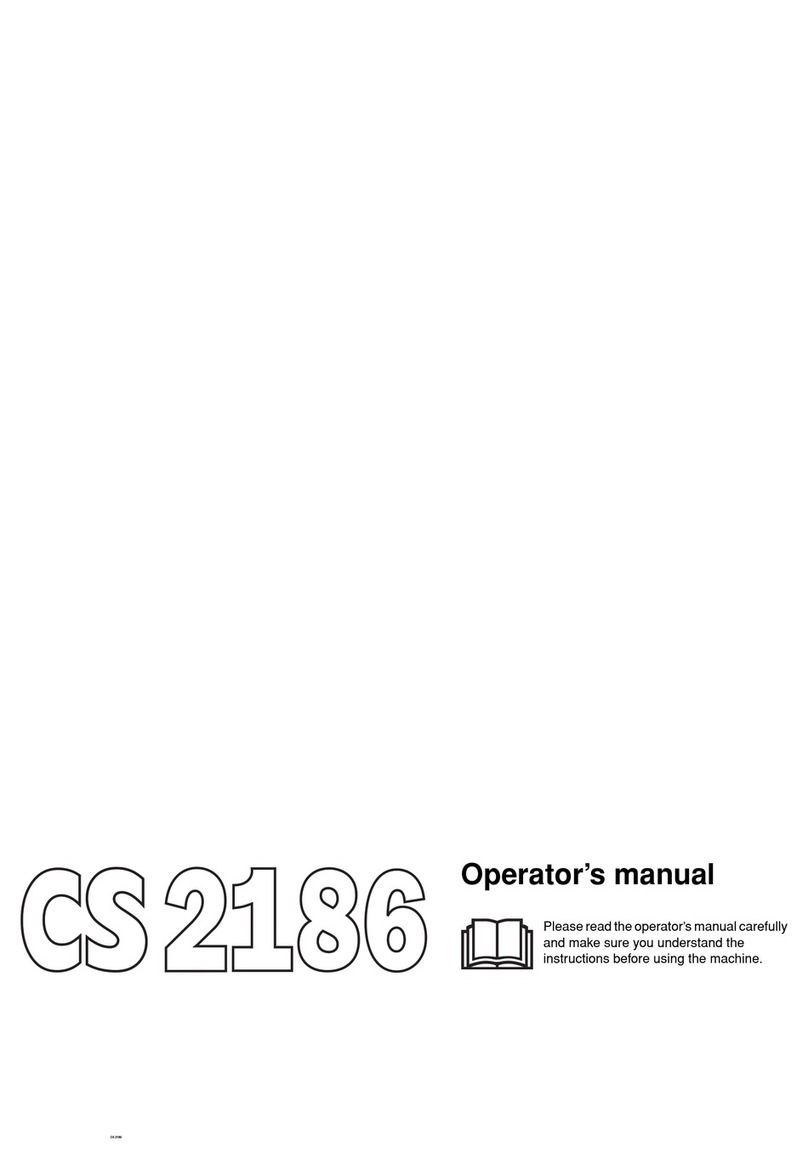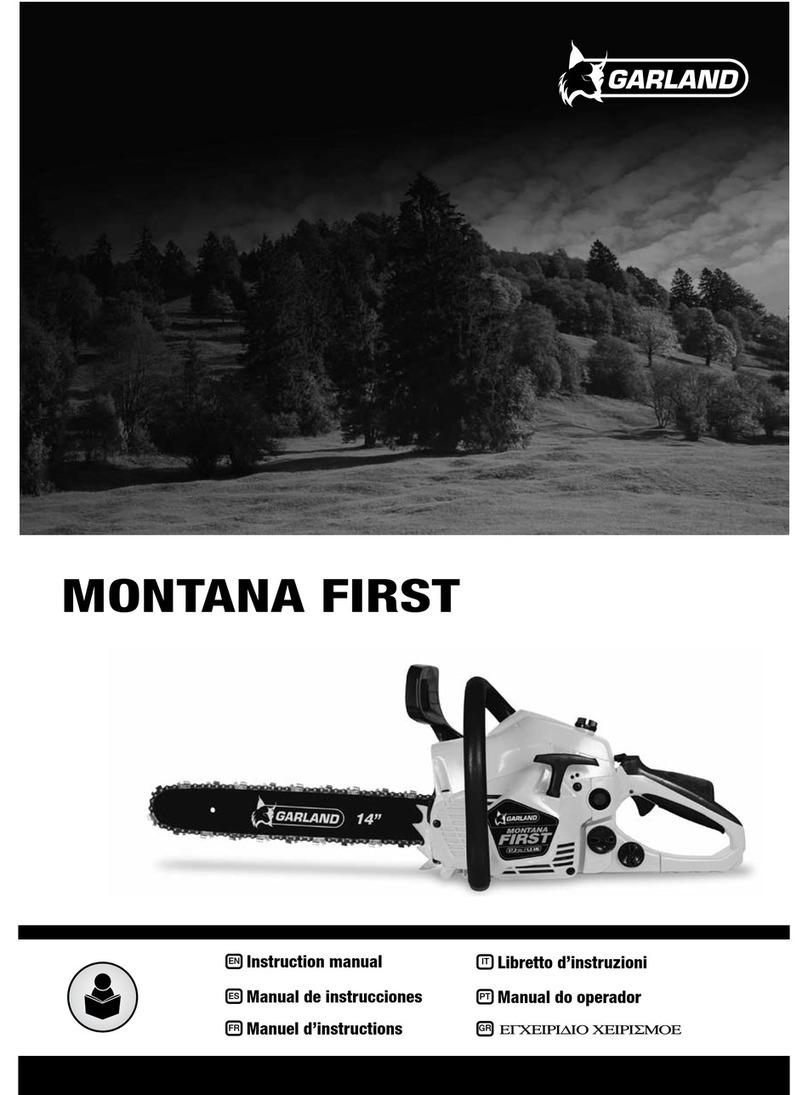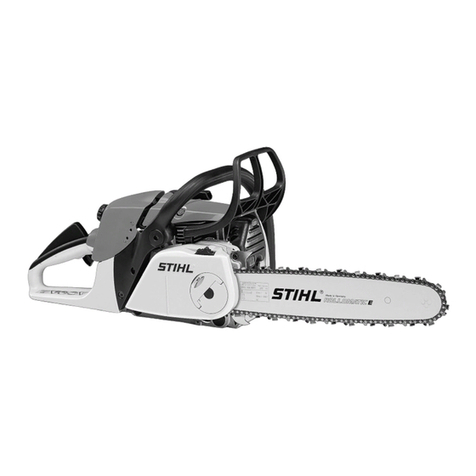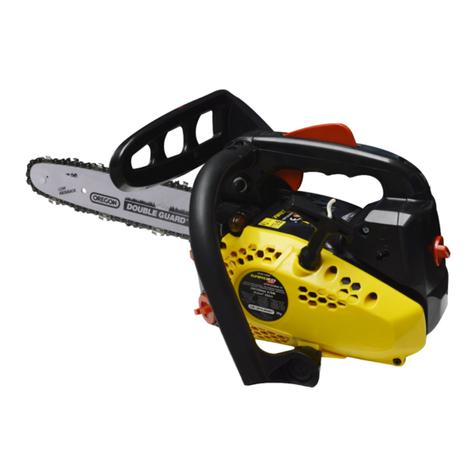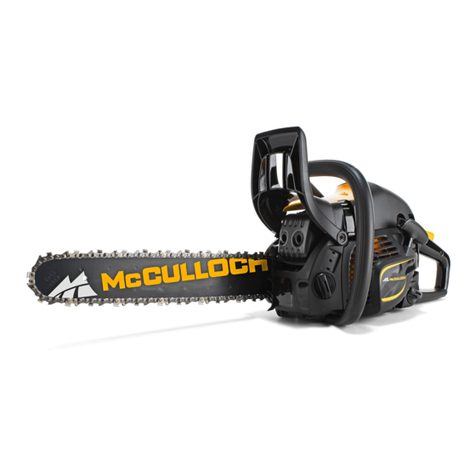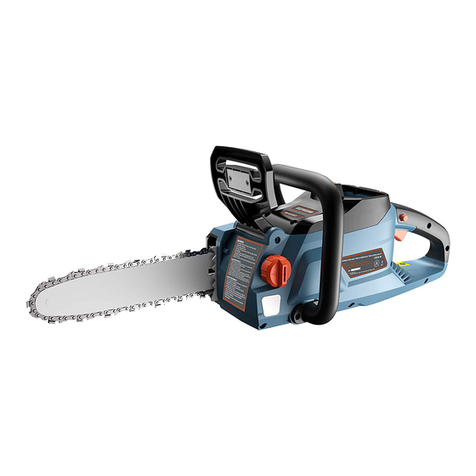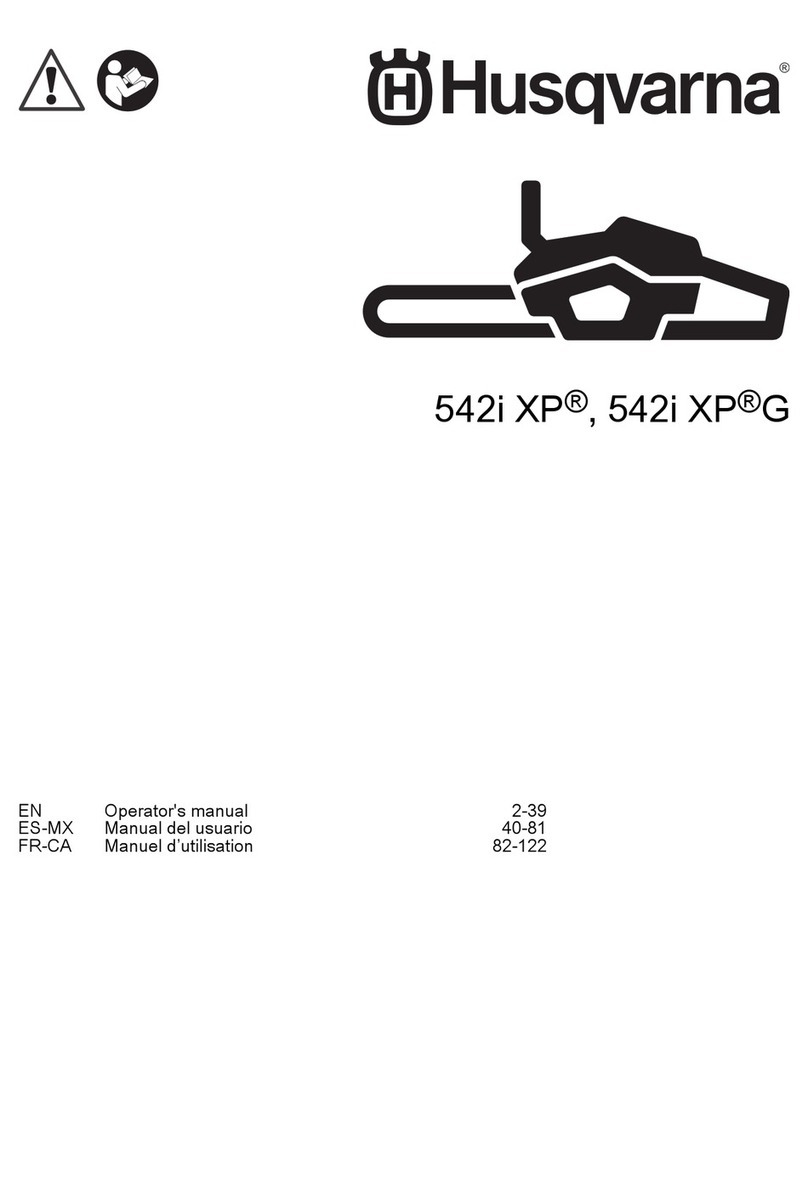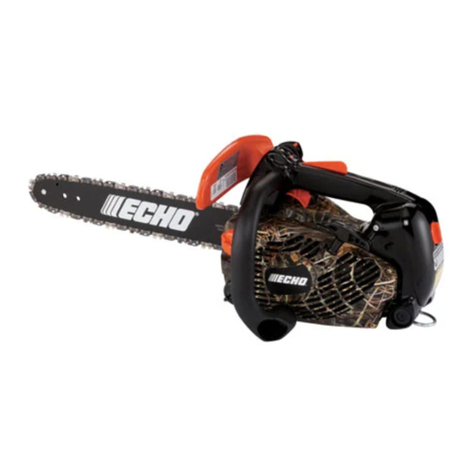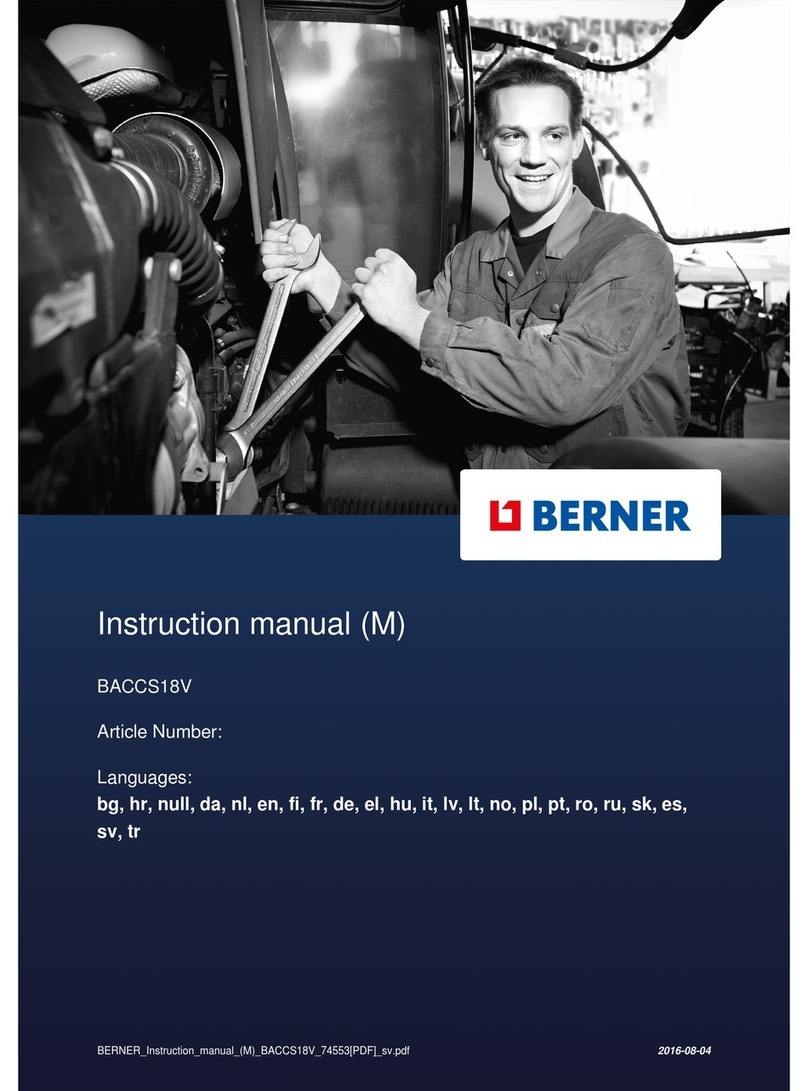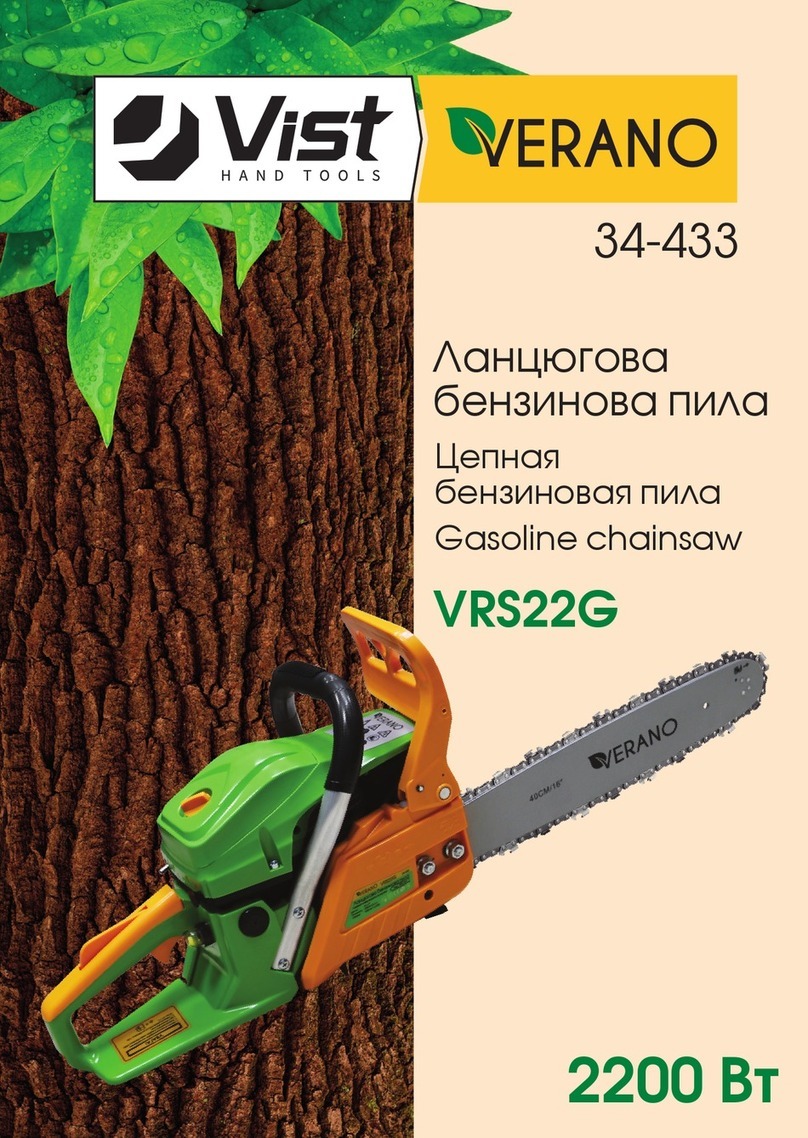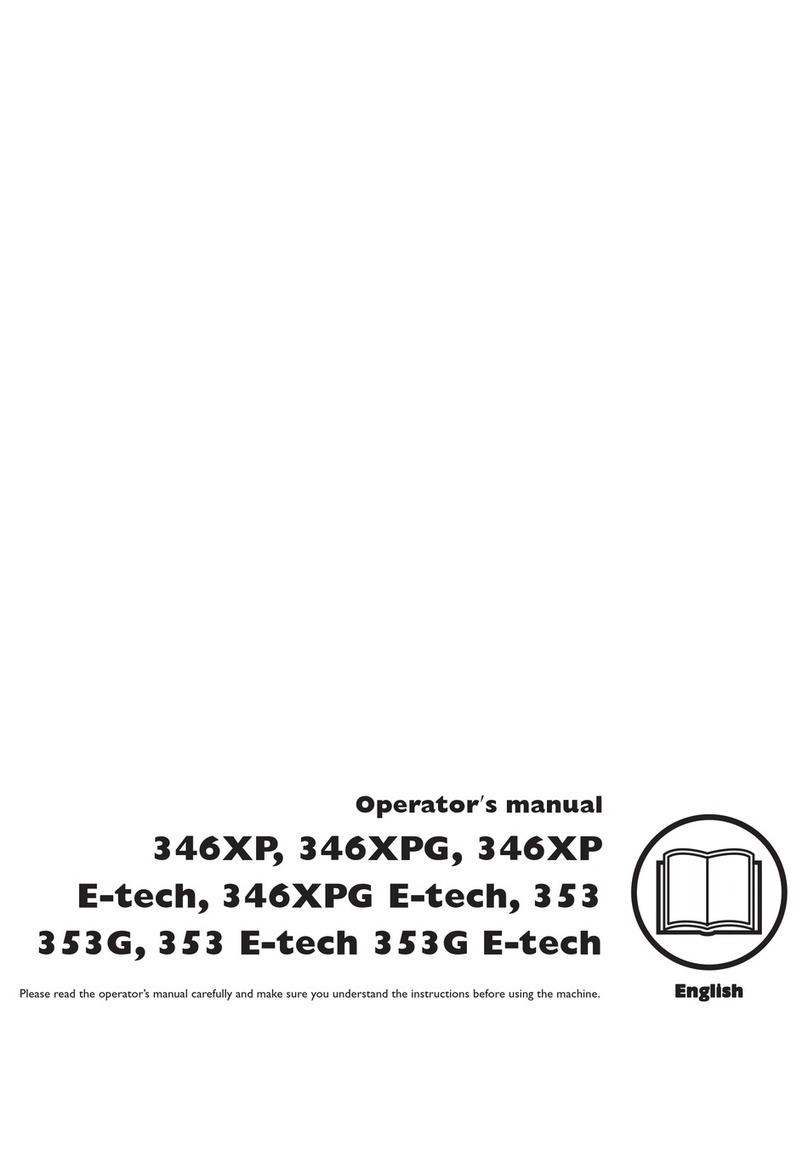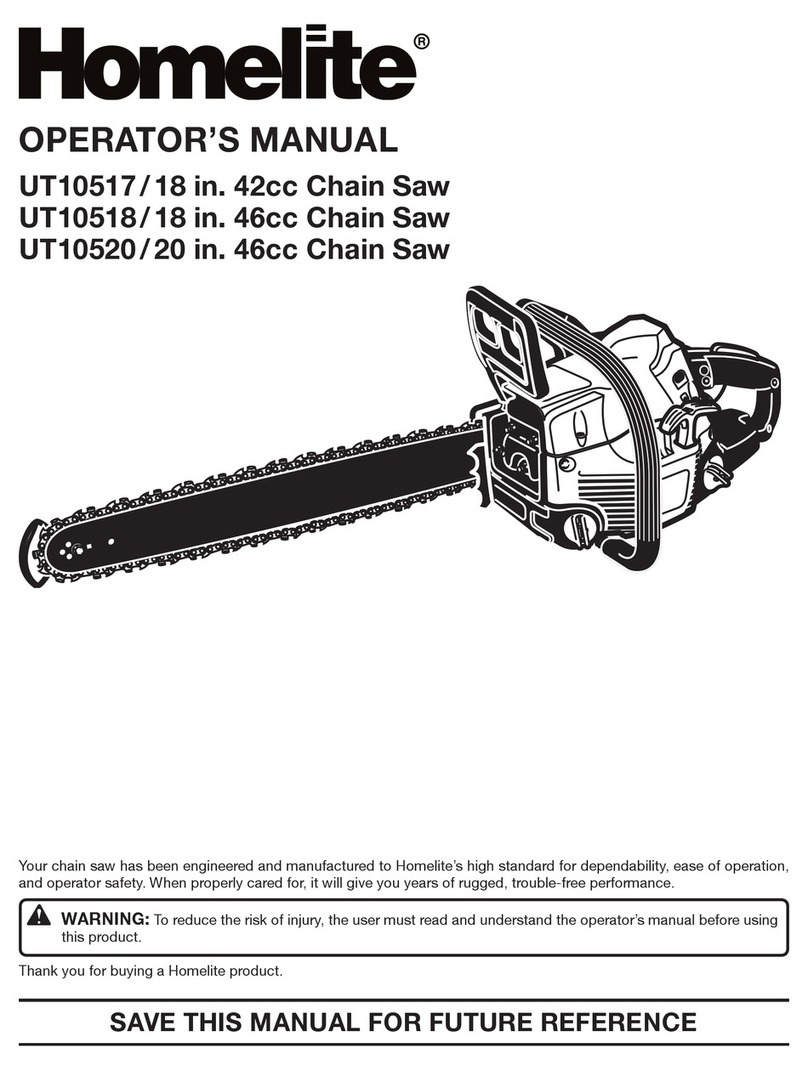TCK TRT3841CW User manual

TRT3841CW –TRT4345CW
FR TRONÇONNEUSE
NL KETTINGZAAG
GB CHAINSAW 2008

A

B
C

D
E

F
G

F

I

FR
TRONÇONNEUSE
MISE EN GARDE
Pour votre propre sécurité, lisez
préalablement ce manuel d’utilisation avant
d’utiliser la machine.
CONSIGNES DE SÉCURITÉ
Lors d’emploi de la machine, observez
toujours scrupuleusement les consignes
de sécurité fournies ainsi que les consignes
de sécurité complémentaires ci-dessous.
Dans ce manuel sont employés les
pictogrammes suivants :
Risque de lésion corporelle
ou de dégâts matériels.
La machine est munie des pictogrammes
suivants :
Portez un masque de
protection.
N’utilisez pas la machine
sous la pluie ni dans des
endroits humides.
Éloignez les mains et les
pieds des pièces
coupantes.
Risque de projection
d’objets.
Consultez le manuel.
CONSIGNES DE SÉCURITÉ
SUPPLÉMENTAIRES POUR LES
TRONÇONNEUSES
_ Les tronçonneuses ne doivent pas être utilisées
par des enfants ou des personnes non formées.
_ Vérifiez la machine avant de l’utiliser.
Si la machine était endommagée, ne l’utilisez pas.
_ Si la machine est endommagée, faites-la
réparer par un technicien agréé.
_ Avant de l’utiliser, prévoyez un chemin sécurisé
pour éviter les chutes d’arbre ou de branchage.
_ Portez des vêtements de protection bien
ajustés pour protéger votre corps.
_ Portez un casque.
_ Portez des gants.
_ Portez des chaussures de protection.
_ Adoptez une position stable pendant
l’utilisation.
_ N’utilisez jamais la machine pour scier du
bois d’ouvrage.
_ N’utilisez jamais la machine pour scier du
bois jeune ou de petits buissons.
_ N’utilisez jamais la machine pour scier
des pièces métalliques.
_ N’utilisez jamais la machine pour scier
dans la terre.
_ N’utilisez pas la machine en présence
d’enfants ou d’animaux.
_ Utilisez la machine uniquement de jour ou
avec un bon éclairage.
_ Utilisez uniquement la machine en pointant
la chaîne dans la direction opposée à celle
du corps. N’allumez jamais la machine
dans une autre position.
_ Pendant l’utilisation, maintenez pieds et
mains éloignés de la chaîne.
_ Évitez de toucher la chaîne.
_ Avant de poser la machine, éteignez-la et
attendez que la chaîne soit complètement
immobile. N’essayez jamais d’immobiliser
vous-même la chaîne.
Assurez-vous que, après
avoir éteint la machine, la
chaîne continue à tourner
pendant quelques instants.
_ Utilisez exclusivement les accessoires
fournis par le fabricant.
_ Éteignez la machine une fois le travail terminé,
avant tout entretien ou lorsque la machine ne doit
pas être utilisée pendant une période prolongée.
_ Après utilisation, rangez la machine en sécurité,
hors de portée des enfants.
Recul
Le recul correspond au mouvement vers le haut et
l’arrière du guide de chaîne lorsque la chaîne
touche inopinément un objet.
Maintenez fermement la machine avec les deux
mains lorsque le moteur tourne.
Maintenez fermement les poignées.
Restez concentré sur le travail effectué.
Le recul est habituellement provoqué par :
- un contact involontaire de la chaîne en
mouvement avec des branches et autres objets ;
- un contact avec des matériaux durs (par ex. métal,
mortier) proches ou dans le bois ;
- une chaîne émoussée ;
- une chaîne présentant une tension incorrecte ;
- le fait de scier plus haut que la ligne des épaules ;
- un défaut d’attention lors du travail ;
- une position instable ;
- le fait de scier dans une trace de coupe existante.

DESCRIPTION (fig.A)
Votre tronçonneuse a été conçue pour scier
des arbres et du bois épais et ferme. Elle est
adaptée à un usage par des droitiers.
1 Accélérateur
2 Bouton de déblocage
3 Démarreur
4 Interrupteur d’arrêt
5 Cordon de démarrage
6 Volet de départ
7 Poignée principale
8 Poignée de guidage
9 Carter de protection
10 Guide chaîne
11 Chaîne
12 Orifice de remplissage de l’huile
13 Orifice de remplissage de carburant
14 Carter de protection
Montage de la chaîne (fig. B & C)
_ Posez la machine sur une surface stable.
_ Desserrez les écrous (15) et enlevez-les.
_ Retirez la protection de chaîne (16).
_ Placez la chaîne (11) par dessus le guide
(10), les dents pointant dans le sens de la rotation.
_ Serrez la chaîne afin de créer une boucle à
l’arrière du guide de chaîne.
_ Placez le guide avec la chaîne sur la machine.
Montez la chaîne sur la roue d’entraînement (17).
_ Placez la fente (18) dans le guide sur les filetages
de vis (19).
_ Replacez la protection de la chaîne.
_ Replacez les écrous et serrez-les fermement.
_ Vérifiez si la chaîne est correctement montée sur
le guide.
_ Tendez la chaîne. Ne la tendez pas trop.
Éteignez toujours la
machine avant de monter la
chaîne.
Contrôle et réglage de la tension de chaîne
(fig. C & D)
La tension de la chaîne doit être contrôlée avant
chaque utilisation et toutes les 10 minutes en cours
de fonctionnement.
_ Soulevez légèrement la chaîne (11) de son
guide (10).
La chaîne présente une tension correcte si elle
recule lorsque vous pouvez la soulever de 3 mm sur
le guide. La chaîne ne doit pas pendre entre le
guide et la chaîne au niveau de la partie inférieure.
Si la tension de la chaîne est incorrecte, procédez
comme suit :
_ Desserrez les écrous (15) de quelques tours.
_ Tournez la vis de réglage (20) vers la droite pour
augmenter la tension.
_ Tournez la vis de réglage vers la gauche pour
réduire la tension.
_ Serrez les écrous.
Avant de contrôler et de
régler la tension de la
chaîne, n’oubliez jamais
d’éteindre la machine.
Activation du frein de chaîne (fig. E)
Le fonctionnement du frein de chaîne doit être
vérifié avant chaque utilisation.
_ Poussez la protection (9) dans la direction de la
chaîne (11) pour activer le frein.
_ Poussez la protection (9) dans la direction de la
poignée (8) pour désactiver le frein.
Instructions d’emploi
_ Retirez la housse de protection de la
tronçonneuse.
_ Saisissez la machine avec les deux mains
tenant les deux poignées. Ce qui vous
permettra de très bien maîtriser la machine.
_ N’utilisez pas la machine au dessus de
la ligne des épaules.
_ Utilisez la machine uniquement sur du bois sec.
_ Pour la première utilisation de cette machine, il est
conseillé de travailler sur un chevalet de sciage.
_ Ne commencez jamais à scier avant que la
machine ne fonctionne à plein régime et que la
garde dentée ne touche le bois.
_ Commencez toujours par une nouvelle trace de
coupe. Ne commencez jamais à scier sur une trace
de coupe existante.
Sciage de rondins
_ Si possible, utilisez toujours un chevalet de sciage.
_ Commencez toujours la coupe avec la chaîne en
mouvement et la garde dentée contre le bois.
_ Faites pivoter la garde dentée contre le bois pour
finaliser la coupe.
La technique de sciage dépend de la façon dont le
rondin est soutenu.
Soutien sur toute la longueur (le rondin est au sol) :
_ Sciez verticalement vers le bas.
_ Assurez-vous de ne pas toucher le sol.
Soutien à chaque extrémité (le rondin est sur le
chevalet de sciage) :
_ Sciez verticalement vers le bas jusqu’au tiers de la
section longitudinale.
_ Faites tourner le rondin et reposez-le sur le
chevalet de sciage avec la trace de coupe dirigée
vers le bas.
_ Effectuez une seconde coupe en direction de la
première coupe.
Soutien à une extrémité (le rondin est sur le
chevalet de sciage) :
_ Sciez verticalement vers le bas.
Abattage d’arbres (fig. I & J)
_ Effectuez une coupe horizontale au tiers du
diamètre du tronc. Ensuite, réalisez une coupe
diagonale à un angle de 45° du haut en bas afin de
faire une entaille.
_ Effectuez une coupe de l’autre côté tout en vous
assurant de ne pas scier jusqu’à l’entaille.
_ Placez un coin dans la coupe pour ouvrir le tronc
et abattre l’arbre.

Démarrage du moteur (fig. A)
_ Assurez-vous que l’interrupteur d’arrêt (4)
est en position levée.
_ Poussez le volet de départ (6) à fond.
_ Enfoncez l’accélérateur (1) à mi-course.
_ Appuyez ensuite sur le démarreur (3).
Le bouton de déblocage (2) verrouille l’accélérateur.
_ Desserrez la poignée (7).
_ Tirez doucement sur le cordon de démarrage (5)
jusqu’à sentir une résistance.
_ Tirez fortement sur le cordon de démarrage.
Répétez l’opération jusqu’à ce que le moteur
démarre.
_ Si le moteur fonctionne régulièrement, poussez à
nouveau doucement le volet de départ.
Régulation de la vitesse (fig. A)
_ Appuyez sur le bouton de déblocage (2)
sans le relâcher.
_ Appuyez sur l’accélérateur (1) pour augmenter la
vitesse. Plus vous appuyez sur l’accélérateur, plus
vous augmentez la vitesse de la machine.
Mise en arrêt (fig. A)
_ Faites glisser l’interrupteur d’arrêt (4) en position
abaissée.
NETTOYAGE ET ENTRETIEN
La machine n’exige pas d’entretien particulier.
_ Nettoyez régulièrement les orifices d’aération.
Nettoyage de la machine (fig. A)
La machine doit être nettoyée après chaque
utilisation.
_ Retirez le guide de chaîne (10) de la machine.
_ Retirez la chaîne (11) du guide de chaîne.
_ Nettoyez la machine avec un chiffon doux.
_ Nettoyez le guide de chaîne avec un chiffon doux.
_ Nettoyez la chaîne avec une brosse douce.
_ Appliquez une fine couche d’huile sur le guide de
chaîne pour éviter l’oxydation.
_ Placez la housse de protection sur le guide de
chaîne.
Éteignez toujours la
machine avant de procéder
à son entretien.
Contrôle du niveau d’huile (fig. F)
Le niveau d’huile doit être contrôlé avant chaque
utilisation et toutes les 10 minutes en cours de
fonctionnement.
_ Posez la machine sur le côté, sur une surface
stable.
_ Retirez le bouchon (12) de l’orifice de remplissage.
_ Utilisez une jauge propre pour déterminer le
niveau.
_ Si le niveau est inférieur à 2/3 de la jauge,
remplissez d’huile.
_ Replacez le bouchon.
Contrôle du niveau de carburant (fig. F)
Le niveau de carburant doit être vérifié avant
chaque utilisation.
_ Posez la machine sur le côté, sur une surface
stable.
_ Retirez le bouchon (13) de l’orifice de
remplissage.
_ Utilisez une jauge propre pour déterminer
le niveau.
_ Si le niveau est inférieur à 2/3 de la jauge,
remplissez de carburant.
_ Replacez le bouchon.
Nettoyage du filtre à air (fig. G)
Il convient de nettoyer le filtre à air toutes
les 50 heures de fonctionnement.
_ Desserrez le bouton (21) et retirez le
couvercle (22).
_ Enlevez le filtre (23).
_ Nettoyez le filtre avec de l’alcool ou de
l’éthanol.
_ Essuyez le filtre avec un chiffon doux.
_ Replacez le filtre.
_ Remettez le couvercle et serrez le bouton.
Vérification de la bougie (fig. G & H)
_ Desserrez le bouton (21) et retirez le couvercle
(22).
_ Enlevez le filtre (23).
_ Retirez le câble de bougie (24) de
la bougie (25).
_ Retirez la bougie à l’aide de la clé à bougies.
_ Nettoyez l’électrode (26) à l’aide d’une
brosse métallique.
_ Vérifiez la distance de contact
(valeur correcte : 0,7 - 0,8 mm) et réglez
en tant que besoin.
_ Remettez la bougie.
Affûtage de la chaîne
Faites affûter la chaîne de préférence par un
technicien expérimenté.
_ Amenez la machine chez le revendeur
pour faire affûter la chaîne.
SPÉCIFICATIONS TECHNIQUES
TRT3841CW
Puissance W 1.400
CC 37.2
Hp 1.9
Vitesse à vide min-1 3.000
Longueur de guide de chaîne mm 400
Délai de freinage de la chaîne ms 83.1
Capacité du réservoir d’huile ml 210
Capacité du réservoir de carburant ml 310
Consommation de carburant l/h 0.9
Huile SAE 10W-30
Carburant essence sans plomb
avec huile 2 temps (25:1)
Poids kg 6.5
Niveau de la pression sonore mesuré sur le
lieu de travail :
LpA (pression sonore) dB(A) 94
LWA (puissance sonore) dB(A) 114
Valeur quadratique moyenne pondérée de
l’accélération : 8.33 m/s²

TRT4345CW
Puissance W 1.800
CC 45
Hp 2.4
Vitesse à vide min-1 3.000
Longueur de guide de chaîne mm 440
Délai de freinage de la chaîne ms 68.5
Capacité du réservoir d’huile ml 260
Capacité du réservoir de carburant ml 550
Consommation de carburant l/h 0.9
Huile SAE 10W-30
Carburant essence sans plomb
avec huile 2 temps (25:1)
Poids kg 7.5
Niveau de la pression sonore mesuré sur le
lieu de travail :
LpA (pression sonore) dB(A) 103
LWA (puissance sonore) dB(A) 114
Valeur quadratique moyenne pondérée de
l’accélération : 5.55 m/s²
Prenez des mesures de
protection auditive.
GARANTIE
Pour les clauses de garantie, reportez-vous
aux conditions de garantie ci-jointes.
ENVIRONNEMENT
Si, après un certain temps,
vous décidez de remplacer
votre machine, ne vous en
débarrassez pas avec les
ordures ménagères mais
destinez-la à un traitement
respectueux de
l’environnement.
Fabriqué en Chine 2008

NL
KETTINGZAAG
WAARSCHUWING
Lees voor uw eigen veiligheid deze
gebruiksaanwijzing goed door alvorens de
machine te gebruiken.
VEILIGHEIDSVOORSCHRIFTEN
Volg bij gebruik van de machine altijd de
bijgeleverde veiligheidsvoorschriften en
onderstaande aanvullende veiligheidsvoorschriften
nauwkeurig op.
In deze handleiding worden de volgende
pictogrammen gebruikt:
Gevaar voor lichamelijk
letsel of materiële schade.
Op de machine vindt u de volgende
pictogrammen:
Draag
gezichtsbescherming.
Gebruik de machine niet bij
neerslag of in een vochtige
omgeving.
Houd handen en voeten uit
de buurt van scherpe
delen.
Gevaar voor rondvliegende
objecten.
Raadpleeg de handleiding.
AANVULLENDE VEILIGHEIDSVOORSCHRIFTEN
VOOR KETTINGZAGEN
_ Kettingzagen mogen niet gebruikt worden door
kinderen of ongetrainde personen.
_ Inspecteer de machine voor gebruik.
In geval van beschadiging mag de machine niet
worden gebruikt.
_ Indien de machine is beschadigd, laat u de
beschadiging repareren door een erkend
reparateur.
_ Zorg er voor gebruik voor dat u een veilige uitweg
heeft voor vallende bomen en takken.
_ Draag nauwsluitende, beschermende
kleding om uw lichaam te beschermen.
_ Draag een helm.
_ Draag handschoenen.
_ Draag veiligheidsschoenen.
_ Zorg er tijdens gebruik voor dat u in een stevige
positie staat.
_ Gebruik de machine niet voor het zagen van
bewerkt timmerhout.
_ Gebruik de machine niet voor het zagen van jong
hout en kort struikgewas.
_ Gebruik de machine niet voor het zagen van
metaal.
_ Gebruik de machine niet om in de grond te zagen.
_ Gebruik de machine niet terwijl kinderen en/of
dieren in de buurt zijn.
_ Gebruik de machine alleen bij daglicht of bij goede
verlichting.
_ Gebruik de machine alleen met de zaagketting
van u af gericht. Schakel de machine nooit in een
andere positie in.
_ Houd tijdens gebruik altijd uw handen en voeten
uit de buurt van de zaagketting.
_ Voorkom aanraking van de zaagketting.
_ Schakel de machine uit en wacht tot de
zaagketting volledig tot stilstand is gekomen voordat
u de machine wegzet.
Probeer nooit om de zaagketting zelf tot stilstand te
brengen.
Wees erop bedacht dat de
zaagketting na het
uitschakelen nog korte tijd
blijft doordraaien.
_ Gebruik uitsluitend accessoires die door de
fabrikant worden aangeleverd.
_ Schakel de machine uit zodra de werkzaamheden
zijn afgelopen, voordat u
onderhoudswerkzaamheden verricht, of wanneer de
machine niet in gebruik is.
_ Berg de machine na gebruik altijd veilig
op, buiten bereik van kinderen.
Terugslag
Terugslag is de op- en achterwaartse beweging die
het zwaard maakt als de ketting onverwachts met
een voorwerp in aanraking komt. Houd de machine
stevig met beide handen vast wanneer de motor
loopt. Houd de handgrepen stevig vast.
Houd uw aandacht bij de werkzaamheden.
Terugslag wordt meestal veroorzaakt door:
- het onbedoeld raken van takken of andere
voorwerpen met de draaiende ketting;
- het raken harde materialen (bijv. metaal,
cement) in de buurt van of in het hout;
- een botte ketting;
- een ketting die niet op de juiste spanning staat;
- het zagen boven schouderhoogte;
- het gebrek aan aandacht bij de werkzaamheden;
- een instabiele werkhouding;
- het zagen in een eerdere zaagsnede.

BESCHRIJVING (fig. A)
Uw kettingzaag is ontworpen voor het zagen
van bomen en dik, stevig hout. De machine
is alleen geschikt voor rechtshandigen.
1 Accelerator
2 Ontgrendelingsknop
3 Starterregulator
4 Stopschakelaar
5 Startkoord
6 Choke
7 Hoofdhandgreep
8 Extra handgreep
9 Beschermkap
10 Zwaard
11 Ketting
12 Olievulpunt
13 Brandstofvulpunt
14 Beschermhuls
Monteren van de ketting (fig. B & C)
_ Plaats de machine op een stabiele ondergrond.
_ Draai de moeren (15) los en verwijder ze.
_ Verwijder de kettingbeschermer (16).
_ Plaats de ketting (11) over het zwaard
(10), met de tanden in de draairichting.
_ Trek de ketting aan zodat er een lus aan de
achterkant van het zwaard ontstaat.
_ Plaats het zwaard met de ketting op de machine.
Monteer de ketting over het aandrijfwiel (17).
_ Plaats de sleuf (18) in het zwaard over de
schroefdraden (19).
_ Breng de kettingbeschermer weer aan.
_ Breng de moeren weer aan en draai ze vast.
_ Controleer of de ketting goed rondom het
zwaard zit.
_ Breng de ketting op spanning. Trek de
ketting niet te strak aan.
Schakel voor het monteren
van de ketting altijd de
machine uit.
Controleren en afstellen van de
kettingspanning (fig. C & D)
De kettingspanning moet voor ieder gebruik
en na iedere 10 minuten worden gecontroleerd.
_ Licht de ketting (11) iets van het zwaard (10) op.
De ketting heeft de juiste spanning als hij
terugspringt wanneer u haar 3 mm van het zwaard
kunt optrekken. De ketting mag tussen het zwaard
en de ketting aan de onderkant niet doorzakken.
Indien de ketting niet op de juiste spanning
staat, gaat u als volgt te werk:
_ Draai de moeren (15) een aantal slagen los.
_ Draai de instelschroef (20) rechtsom om de
spanning te verhogen.
_ Draai de instelschroef linksom om de spanning te
verlagen.
_ Draai de moeren vast.
Schakel voor het
controleren en afstellen
van de kettingspanning
altijd eerst de machine uit.
Activeren van de kettingrem (fig. E)
De werking van de kettingrem moet voor ieder
gebruik worden gecontroleerd.
_ Duw de beschermkap (9) in de richting van
de ketting (11) om de rem te activeren.
_ Duw de beschermkap (9) in de richting
van de handgreep (8) om de rem te deactiveren.
Aanwijzingen voor gebruik
_ Verwijder de beschermhuls van de zaagketting.
_ Houd de machine met beide handen aan
de twee handgrepen vast. Op die manier
heeft u de meeste controle over de machine.
_ Gebruik de machine niet boven schouderhoogte.
_ Gebruik de machine uitsluitend voor het
bewerken van droog hout.
_ Indien u deze machine voor de eerste keer
gebruikt, is het raadzaam de werkzaamheden
op een zaagbok te verrichten.
_ Begin nooit met zagen voordat de machine op
volle toeren draait en de gekartelde stootrand het
hout raakt.
_ Maak altijd een nieuwe zaagsnede.
Gebruik nooit een eerdere zaagsnede om verder te
zagen.
Blokken zagen
_ Gebruik indien mogelijk altijd een zaagbok.
_ Begin een zaagsnede altijd met een draaiende
ketting en de gekartelde stootrand tegen het hout.
_ Draai de gekartelde stootrand tegen het hout om
een zaagsnede te voltooien.
De wijze van zagen is afhankelijk van de wijze
waarop het blok wordt ondersteund.
Ondersteuning over de volle lengte (het blok ligt op
de grond):
_ Maak een verticale zaagsnede omlaag.
_ Zorg ervoor dat u de grond niet raakt.
Ondersteuning aan beide uiteinden (het blok ligt op
de zaagbok):
_ Maak een verticale zaagsnede omlaag tot
een derde van de lengtedoorsnede.
_ Draai het blok om en leg het op de zaagbok met
de zaagsnede naar beneden.
_ Maak een tweede zaagsnede naar de eerste
snede toe.
Ondersteuning aan een uiteinde (het blok ligt op de
zaagbok):
_ Maak een verticale zaagsnede omlaag.
Bomen zagen (fig. I & J)
_ Maak een horizontale zaagsnede tot een
derde van de stamdiameter. Maak vervolgens een
diagonale zaagsnede onder een hoek van ca. 45°
van boven naar beneden, zodat een inkeping
ontstaat.
_ Maak een zaagsnede aan de andere kant,
maar zorg ervoor dat u niet door de inkeping zaagt.
_ Plaats een wig in de zaagsnede om een
opening te maken en de boom te laten vallen.
Starten van de motor (fig. A)
_ Zorg ervoor dat de stopschakelaar (4) naar boven
is geschakeld.
_ Trek de choke (6) volledig uit.
_ Druk de accelerator (1) half in.
_ Druk vervolgens de starterregulator (3) in.

De ontgrendelingsknop (2) vergrendelt de
accelerator.
_ Laat de handgreep (7) los.
_ Trek voorzichtig aan het startkoord (5) tot
u weerstand voelt.
_ Trek krachtig aan het startkoord.
Herhaal dit tot de motor start.
_ Indien de motor soepel loopt, duwt u de
choke langzaam weer in.
Reguleren van de snelheid (fig. A)
_ Houd de ontgrendelingsknop (2) ingedrukt.
_ Druk de accelerator (1) in om de snelheid te
vergroten. Hoe verder u de accelerator indrukt, des
te hoger het toerental van de machine.
Uitschakelen (fig. A)
_ Schuif de stopschakelaar (4) naar beneden.
REINIGING EN ONDERHOUD
De machine vergt geen speciaal onderhoud.
_ Reinig regelmatig de ventilatieopeningen.
Reinigen van de machine (fig. A)
De machine dient na ieder gebruik te worden
gereinigd.
_ Verwijder het zwaard (10) van de machine.
_ Verwijder de ketting (11) van het zwaard.
_ Reinig de machine met behulp van een zachte
doek.
_ Reinig het zwaard met behulp van een zachte
doek.
_ Reinig de ketting met behulp van een zachte
borstel.
_ Breng een dunne laag olie aan op het zwaard om
oxidatie te voorkomen.
_ Plaats de beschermhuls over het zwaard.
Schakel voordat u
onderhoud aan de machine
verricht altijd eerst de
machine uit.
Controleren van het oliepeil (fig. F)
Het oliepeil moet voor ieder gebruik en na iedere 10
minuten worden gecontroleerd.
_ Plaats de machine op haar zijkant op een stabiele
ondergrond.
_ Verwijder de stop (12) van het vulpunt.
_ Gebruik een schone stok om het peil te bepalen.
_ Indien het peil onder 2/3 van het voor meting
gebruikte deel reikt, vult u olie bij.
_ Breng de stop weer aan.
Controleren van het brandstofpeil (fig. F)
Het brandstofpeil moet voor ieder gebruik worden
gecontroleerd.
_ Plaats de machine op haar zijkant op een stabiele
ondergrond.
_ Verwijder de stop (13) van het vulpunt.
_ Gebruik een schone stok om het peil te bepalen.
_ Indien het peil onder 2/3 van het voor meting
gebruikte deel reikt, vult u brandstof bij.
_ Breng de stop weer aan.
Reinigen van het luchtfilter (fig. G)
Het luchtfilter dient na iedere 50 bedrijfsuren
te worden gereinigd.
_ Draai de knop (21) los en verwijder het
deksel (22).
_ Verwijder de filter (23).
_ Reinig het filter met spiritus of ethanol.
_ Droog het filter met een zachte doek.
_ Breng het filter weer aan.
_ Breng het deksel weer aan en draai de
knop vast.
Controleren van de bougie (fig. G & H)
_ Draai de knop (21) los en verwijder het
deksel (22).
_ Verwijder de filter (23).
_ Verwijder de bougiekabel (24) van de
bougie (25).
_ Verwijder de bougie met behulp van de
bougiesleutel.
_ Reinig de elektrode (26) met behulp van
een staalborstel.
_ Controleer de contactafstand (correcte
waarde 0,7 - 0,8 mm) en stel deze af
indien nodig.
_ Breng de bougie weer aan.
Aanscherpen van de ketting
De ketting dient bij voorkeur door een erkend
technicus te worden geslepen.
_ Breng de machine naar uw dealer om de ketting
te laten scherpen.
TECHNISCHE GEGEVEN
TRT3841CW
Vermogen W 1.400
CC 37.2
Hp 1.9
Toerental (onbelast) min-1 3.000
Lengte zwaard mm 400
Uitlooptijd ketting ms 83.1
Capaciteit oliereservoir ml 210
Capaciteit brandstofreservoir ml 310
Brandstofverbruik l/h 0.9
Olie SAE 10W-30
Brandstof loodvrije benzine met tweetaktolie (25:1)
Gewicht kg 6.5
Niveau van de geluidsdruk op de werkplek:
LpA (geluidsdruk) dB(A) 94
LWA (geluidsvermogen) dB(A) 114
Gewogen kwadratische gemiddelde waarde
van de versnelling: 8,33 m/s²

TRT4345CW
Vermogen W 1.800
CC 45
Hp 2.4
Toerental (onbelast) min-1 3.000
Lengte zwaard mm 440
Uitlooptijd ketting ms 68.5
Capaciteit oliereservoir ml 260
Capaciteit brandstofreservoir ml 550
Brandstofverbruik l/h 0.9
Olie SAE 10W-30
Brandstof loodvrije benzine met tweetaktolie (25:1)
Gewicht kg 7.5
Niveau van de geluidsdruk op de werkplek:
LpA (geluidsdruk) dB(A) 103
LWA (geluidsvermogen) dB(A) 114
Gewogen kwadratische gemiddelde waarde
van de versnelling: 5.55 m/s²
Neem maatregelen voor
gehoorbescherming.
GARANTIE
Voor de garantiebepalingen wordt verwezen
naar de bijgevoegde garantievoorwaarden.
MILIEU
Als uw machine na verloop
van tijd aan vervanging toe
is, geef hem dan niet met het
huisvuil mee, maar zorg voor
een milieuvriendelijke
verwerking.
Made in China 2008

GB
CHAINSAW
WARNING
Read this manual carefully before using the
machine, for your own safety.
SAFETY INSTRUCTIONS
When using the machine, always observe
the enclosed safety instructions as well as
the additional safety instructions.
The following symbols are used throughout
this manual:
Denotes risk of personal
injury or damage to the
tool.
You will find the following symbols on the
machine:
Wear face protection.
Do not use the machine in
precipitation or in humid
surroundings.
Keep your hands and feet
away from sharp parts.
Risk of flying objects.
Consult the manual.
ADDITIONAL SAFETY INSTRUCTIONS
FOR CHAINSAWS
_ Chainsaws must not be used by children or
untrained persons.
_ Check the machine before use. Should the
machine be damaged, it must not be used.
_ If the machine is damaged, have the damage
repaired by an authorized repair agent.
_ Before use make sure that you have a safe
way out for falling trees and branches.
_ Wear well-fitting, protective clothing to protect
your body.
_ Wear a helmet.
_ Wear gloves.
_ Wear safety shoes.
_ During use make sure that you stand in a
firm position.
_ Never use the machine for sawing worked
timber.
_ Never use the machine for sawing young
wood and small bushes.
_ Never use the machine for sawing metal.
_ Never use the machine for sawing into the
ground.
_ Do not use the machine in the presence of
children and/or animals.
_ Only use the machine in daylight or with
good lighting.
_ Only use the machine with the saw chain
pointing away from you. Never switch on
the machine in another position.
_ During use always keep your hands and
feet away from the saw chain.
_ Avoid touching the saw chain.
_ Before putting the machine down, switch
off the machine and wait for the saw chain
to come to a complete standstill.
Never attempt to bring the saw chain to a
standstill yourself.
Beware that after switching
off the saw chain continues
to run for a short period.
_ Only use accessories supplied by the
manufacturer.
_ Switch the machine off when finishing the
activities, before servicing, or when the machine is
not used.
_ After use, always store the machine safely,
outside the reach of children.
Kickback
Kickback is the upward and backward movement of
the bar when the chain unexpectedly touches an
object. Securely hold the machine with both hands
when the motor is running. Securely hold the
handles.
Keep your attention focused on the operation.
Kickback is usually caused by:
- unintentionally touching branches and
other objects with the running chain;
- touching hard materials (e.g. metal, mortar) close
to or in the wood;
- a blunt chain;
- a chain that is not at the correct tension;
- sawing above shoulder height;
- a lack of attention to the operation;
- an instable stance;
- sawing into a previous cut.

DESCRIPTION (fig. A)
Your chainsaw has been designed for
sawing trees and thick, firm wood. The
machine is only suitable for right-hand use.
1 Accelerator
2 Lock-off button
3 Starter throttle
4 Stop switch
5 Start cord
6 Choke
7 Main handle
8 Guide handle
9 Guard
10 Bar
11 Chain
12 Oil filling point
13 Fuel filling point
14 Protective case
Mounting the chain (fig. B & C)
_ Place the machine on a stable underground.
_ Loosen the nuts (15) and remove them.
_ Remove the chain guard (16).
_ Place the chain (11) over the bar (10),
with the teeth pointing in the direction of rotation.
_ Tighten the chain so that a loop is created at the
back of the bar.
_ Place the bar with the chain on the machine.
Mount the chain over the driving wheel (17).
_ Place the slot (18) in the bar over the screw
threads (19).
_ Replace the chain guard.
_ Replace the nuts and tighten them securely.
_ Check if the chain is properly fitted around the bar.
_ Tension the chain. Do not over-tighten the chain.
Before mounting the chain
always switch off the
machine.
Checking and adjusting the chain tension
(fig. C & D)
The chain tension must be checked before
each use and after each 10 minutes of use.
_ Slightly raise the chain (11) from the bar (10).
The chain has the correct tension if it recoils when
you can pull it up 3 mm from the bar.
The chain should not sag between the bar and the
chain on the bottom side.
If the chain is not at the correct tension, proceed as
follows:
_ Slacken the nuts (15) a few threads.
_ Turn the set screw (20) to the right to increase the
tension.
_ Turn the set screw to the left to reduce the
tension.
_ Tighten the nuts.
Before checking and
adjusting the chain
tension, always switch
off the machine.
Activating the chain brake (fig. E)
The operation of the chain brake must be
checked before each use.
_ Push the guard (9) into the direction of the chain
(11) to activate the brake.
_ Push the guard (9) into the direction of the handle
(8) to deactivate the brake.
Instructions for use
_ Remove the protective cover from the saw
chain.
_ Hold the machine with both hands using both
grips. This ensures optimum control over the
machine.
_ Do not use the machine above shoulder height.
_ Only use the machine for working dry wood.
_ If you use this machine for the first time, it is
advisable to work on a saw horse.
_ Never start sawing before the machine is running
at full speed and the serrated fender touches the
wood.
_ Always make a new cut. Never use a previous cut
to proceed sawing.
Sawing blocks
_ If possible, always use a saw horse.
_ Always start a cut with the chain running
and the serrated fender against the wood.
_ Rotate the serrated fender against the wood to
complete a cut.
The way of sawing depends on the way the
block is being supported.
Full-length support (the block is on the ground):
_ Make a vertical cut downwards.
_ Make sure that you do not touch the ground.
Support at both ends (the block is on the saw
horse):
_ Make a vertical cut downwards to one
third of the longitudinal section.
_ Rotate the block and lay it on the saw horse with
the cut pointing downwards.
_ Make a second cut towards the first cut.
Support at one end (the block is on the saw horse):
_ Make a vertical cut downwards.
Sawing trees (fig. I & J)
_ Make a horizontal cut to one third of the diameter
of the trunk. Subsequently make a diagonal cut at a
45° angle from top to bottom so that a notch is
created.
_ Make a cut on the other side, but make sure that
you do not saw through the notch.
_ Place a wedge in the cut to make an opening and
drop the tree.
Starting the motor (fig. A)
_ Make sure that the stop switch (4) is in the upward
position.
_ Fully pull out the choke (6).
_ Press the accelerator (1) halfway.
_ Subsequently press the starter throttle (3).
The lock-off button (2) locks the accelerator.
_ Release the handle (7).
_ Pull gently on the start cord (5) until you
feel resistance.
_ Pull the start cord forcefully. Repeat this until the
motor is starting.

_ If the motor runs smoothly, slowly push
the choke again.
Regulating the speed (fig. A)
_ Keep the lock-off button (2) depressed.
_ Press the accelerator (1) to increase the
speed. The further you press the accelerator,
the higher the speed of the machine.
Switching off (fig. A)
_ Slide the stop switch (4) to the downward
position.
CLEANING AND MAINTENANCE
The machine does not require any special
maintenance.
_ Regularly clean the ventilation slots.
Cleaning the machine (fig. A)
The machine must be cleaned after each use.
_ Remove the bar (10) from the machine.
_ Remove the chain (11) from the bar.
_ Clean the machine using a soft cloth.
_ Clean the bar using a soft cloth.
_ Clean the chain using a soft brush.
_ Apply a thin layer of oil to the bar to avoid
oxidation.
_ Place the protective cover over the bar.
Before performing
maintenance to the
machine, always switch
off the machine.
Checking the oil level (fig. F)
The oil level must be checked before each
use and after each 10 minutes of use.
_ Place the machine on its side on a stable
underground.
_ Remove the plug (12) from the filling point.
_ Use a clean stick to determine the level.
_ If the level is below 2/3 of the part used
for measurement, refill the oil.
_ Replace the plug.
Checking the fuel level (fig. F)
The fuel level must be checked before each use.
_ Place the machine on its side on a stable
underground.
_ Remove the plug (13) from the filling point.
_ Use a clean stick to determine the level.
_ If the level is below 2/3 of the part used
for measurement, refill the fuel.
_ Replace the plug.
Cleaning the air filter (fig. G)
The air filter must be cleaned every 50 operating
hours.
_ Loosen the knob (21) and remove the cover (22).
_ Remove the filter (23).
_ Clean the filter with spirits or ethanol.
_ Dry the filter with a soft cloth.
_ Replace the filter.
_ Replace the cover and tighten the knob.
Checking the spark plug (fig. G & H)
_ Loosen the knob (21) and remove the cover (22).
_ Remove the filter (23).
_ Remove the spark plug cable (24) from the spark
plug (25).
_ Remove the spark plug using the spark plug
spanner.
_ Clean the electrode (26) using a steel brush.
_ Check the contact distance (correct value
0.7 - 0.8 mm) and adjust as necessary.
_ Replace the spark plug.
Sharpening the chain
The chain should preferably be sharpened
by a recognised technician.
_ Take the machine to your dealer to have
the chain sharpened.
TECHNICAL DATA
TRT3841CW
Power input W 1.400
CC 37.20
Hp 1.9
No-load speed min-1 3000
Bar length mm 400
Chain brake time ms 83.1
Oil container capacity ml 210
Fuel container capacity ml 310
Fuel consumption kg/h 0.9
Oil SAE 10W-30
Fuel unleaded gasoline with 2-cycle oil (25:1)
Weight kg 6.5
Level of sound pressure:
LpA (sound pressure) dB(A) 94
LWA (acoustic power) dB(A) 114
Weighted root mean square acceleration
value: 8.33 m/s²
TRT4345CW
Power input W 1.800
CC 45
Hp 2.4
No-load speed min-1 3.000
Bar length mm 440
Chain brake time ms 68.5
Oil container capacity ml 260
Fuel container capacity ml 550
Fuel consumption kg/h 0.9
Oil SAE 10W-30
Fuel unleaded gasoline with 2-cycle oil (25:1)
Weight kg 7.5
Level of sound pressure:
LpA (sound pressure) dB(A) 103
LWA (acoustic power) dB(A) 114
Weighted root mean square acceleration
value: 5.55 m/s²

Take appropriate measures
for the protection of
hearing.
GUARANTEE
Refer to the enclosed guarantee conditions
for the terms and conditions of guarantee.
ENVIRONMENT
Should your machine need
replacement after extended
use, do not put it in the
domestic waste but dispose
of it in an environmentally
safe way.
Made in China 2008

This manual suits for next models
1
Table of contents
Languages:
